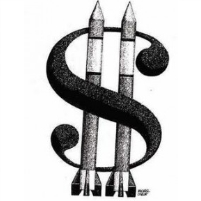Modern Wars: Fewer Soldiers, More Money
Wednesday, July 28, 2010

When the United States fought World War II, it spent $4.1 trillion (in inflation-adjusted dollars) while putting together a fighting force of 16 million men and women and battling the Axis powers (Japan, Germany, Italy) on three continents. Flash forward to America’s first wars of the 21st century, Afghanistan and Iraq, which have managed to consume about a quarter of the WWII expenditure (or $1.1 trillion) while requiring a fighting force much, much smaller in size.
Todd Harrison of the Center for Strategic and Budgetary Assessments told The New York Times that it costs about $1.1 million a year to support an American serving in Afghanistan, whereas it cost only $67,000 each for troops in World War II and $132,000 for the Vietnam War.
But the modern per-soldier cost of fighting wars isn’t the most disturbing aspect of the current conflicts. In the 1940s, the struggle of fighting a two-front war ate up nearly 36% of the gross domestic product (GDP), thanks to the United States having a much smaller economy back then. Now, the “burden” of Iraq and Afghanistan amounts to only 1.2% of the GDP, because the U.S. has so much more money to spend—either from economic output or just heavy borrowing from banks.
“The army is at war, but the country is not,” David Kennedy, a Stanford University historian, told the Times. “We have managed to create and field an armed force that can engage in very, very lethal warfare without the society in whose name it fights breaking a sweat.” The result, he added, is “a moral hazard for the political leadership to resort to force in the knowledge that civil society will not be deeply disturbed.”
Another remarkable fact: Iraq and Afghanistan have been fought without raising taxes, the first time America has engaged in major wars without levying taxpayers for help since the Revolution. In fact, significant tax cuts were implemented last decade while thousands of soldiers were shipped overseas, helping to create the staggering deficit and ballooning national debt of today.
-Noel Brinkerhoff
The War: A Trillion Can Be Cheap (by Elisabeth Bumiller, New York Times)
Comparing the Costs of America’s Wars (New York Times)
Costs of Major U.S. Wars (by Stephen Daggett, Congressional Research Service) (pdf)
- Top Stories
- Unusual News
- Where is the Money Going?
- Controversies
- U.S. and the World
- Appointments and Resignations
- Latest News
- Trump to Stop Deportations If…
- Trump Denounces World Series
- What If China Invaded the United States?
- Donald Trump Has a Mental Health Problem and It Has a Name
- Trump Goes on Renaming Frenzy






Comments